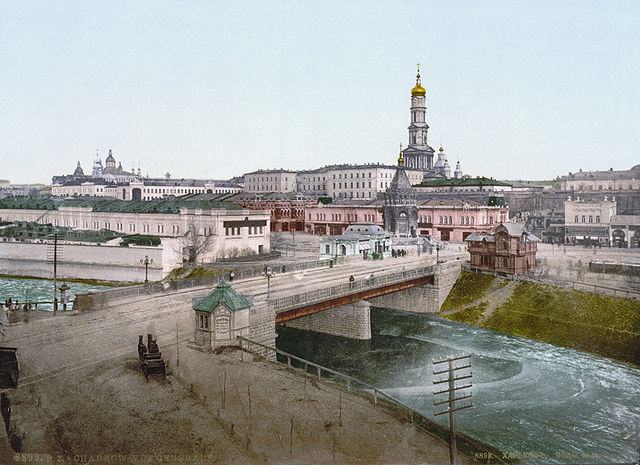Top Qs
Timeline
Chat
Perspective
Timeline of Kharkiv
From Wikipedia, the free encyclopedia
Remove ads
The following is a timeline of the history of the city of Kharkiv, Ukraine.
Prior to 20th century
Historical affiliations
Zaporozhian Cossacks under Tsardom of Russia 1654–1721
Russian Empire 1721–1917
Ukrainian People's Republic 1917–1918
Donetsk–Krivoy Rog Soviet Republic 1918
Ukrainian People's Republic 1918–1919
Ukrainian Soviet Socialist Republic 1919–1922
Soviet Ukraine 1922–1941
Nazi Germany 1941–1943 (occupation)
Soviet Ukraine 1943–1991
Ukraine 1991–present
- 1654 – Kharkiv founded by Zaporozhian Cossacks (regiment's capital of Kharkiv Regiment).
- 1689 – Church of the Intercession (Kharkiv) built.[1]
- 1734 – Kharkov Collegium founded.[2]
- 1764 – Church of the Holy Trinity built.[1]
- 1765 – Town becomes capital of Sloboda Ukraine governetore in Russian Empire.[2]
- 1777 – Assumption Cathedral built.[1]
- 1797 – Town becomes part of the Kharkov Governorate.
- 1805 – Kharkiv University established.[2]
- 1817 – Population: 12,892.[3]
- 1820 – Building of Noble Assembly, Kharkiv constructed on Market Square, Kharkiv.
- 1835 – Town becomes capital of Kharkov Governorate.[2]
- 1867 – Population: 59,968.[4]
- 1868 – Railway begins operating.[2]
- 1878 – Student protest.[5]
- 1882
- 1885 – Technological Institute founded.[8]
- 1886 - Kharkiv Public Library[9] and Museum of Art and Industry[10] established.
- 1893 – Myronosytska Church rebuilt.[1]
- 1895 – Kharkov Locomotive Factory begins operating.
- 1897 – Population: 170,682.
- 1900
Remove ads
20th century

- 1901 – Annunciation Cathedral consecrated.[1]
- 1903 – "People's palace" established.[4]
- 1906 – Tram begins operating.[citation needed]
- 1913
- Choral Synagogue built.
- Population: 258,360.[11]
- 1917 – December: First All-Ukrainian Congress of Soviets (Kharkiv) held in city.
- 1918
- February: City becomes capital of Donetsk–Krivoy Rog Soviet Republic.[2]
- April: troops loyal to the Ukrainian People's Republic take control of Kharkiv together with the German Army.[12]
- 1919
- January: Kharkiv taken by the Red Army.
- March: Annual congress of the Communist Party of Ukraine (Soviet Union) begins in Kharkiv.
- June: Kharkiv taken by the White Army.
- December: Kharkiv retaken by the Red Army.
- 1920
- City becomes capital of the Ukrainian Soviet Socialist Republic.[2]
- Museum of History opens.[10]
- 1921
- 1922 - City becomes part of the Union of Soviet Socialist Republics (USSR).
- 1924 - Kharkov Steam Locomotive Plant housing built.[1]
- 1925 - Football Club Metalist Kharkiv formed.
- 1926
- Traktor Stadium opens.
- Population: 417,342.[15]
- 1927
- Nova Generatsiia literary journal begins publication.[1]
- Morozov Design Bureau (arms industry) established.
- 1928
- 1929
- Institute of Political Education established.
- Palace of Labor, and textile workers' club built.[1]
- 1930
- International Conference of Revolutionary Writers held in city.[14]
- National Aerospace University – Kharkiv Aviation Institute founded.
- 1932
- Holodomor (famine).[18]
- City becomes part of the Kharkiv Oblast.
- 1933 - House of Trade and House of Planning Organizations[1] and KhTZ Stadium built.
- 1934
- Ukrainian SSR capital relocated from Kharkov to Kiev.[15]
- Kharkov Opera House opens.
- International Hotel built.[1]
- Red Factory Theatre built (approximate date).[citation needed]
- 1935
- College of Textile and Design established.[citation needed]
- Shevchenko monument erected in Postyshev Park.[1]
- 1939 – Population: 833,432.[15]
- 1940 – April–May: Execution of Polish officers in Kharkov as part of the Katyn massacre.[19]

- 1941
- 1,200 political prisoners burned alive by the retreating Soviets in the Kharkiv tragedy.
- 20–24 October: First Battle of Kharkov; Germans in power.
- Nazi prison established by the Germans.[20]
- 1942 – 12–28 May: Second Battle of Kharkov.
- 1943
- 19 February-15 March: Third Battle of Kharkov.
- 12–23 August: Fourth Battle of Kharkov; Soviets in power.
- 1947 – Zerkalʹnaya struya (fountain) built.
- 1954
- Kharkov Airport opens.
- Institute of Fire Safety established.[21]
- 1959 - Population: 934,136.
- 1962 - Institute of Radioelectronics established.[citation needed]
- 1964
- Lenin monument erected in Dzerzhinsky Square.
- Kharkiv State Academy of Culture active.
- 1965 – Population: 1,070,000.[22]
- 1972 – 18 May: Airplane crash occurs near city.
- 1975 – Kharkiv Metro begins operating.
- 1979 – Population: 1,485,000.[23]
- 1981 - Kharkiv TV Tower erected.
- 1984 - Kharkiv Metro Bridge opens.
- 1985 - Population: 1,554,000.[24]
- 1988 – Museum of Literature established.[10]
- 1989
- Population: 1,609,959.
- Sister city relationship established with Cincinnati, USA.[25]
- 1990
- UkrSibbank (bank) headquartered in city.
- Mykola Lysenko Kharkiv Academic Opera and Ballet Theatre built.
- 1991 – City becomes part of independent Ukraine.[26]
- 1995 - 1995 Kharkiv drinking water disaster.
Remove ads
21st century
- 2001 - Population: 1,470,902.
- 2002 - Roman Catholic Diocese of Kharkiv-Zaporizhia established.[27]
- 2004 – Palace of Sports "Lokomotiv" arena opens.
- 2006 – 22 April: Supermarket bombings.
- 2010 – Hennadiy Kernes becomes mayor.
- 2012
- June: Some UEFA Euro 2012 football games played in Kharkiv.
- 15 December: Beheadings
- 2014
- 28 April: Attempted assassination of mayor Kernes.
- Kharkiv Battalion established.
- Population: 1,451,132.

See also
- History of Kharkiv
- Other names of Kharkiv (e.g. Charkow, Harkov, Kharkoff, Kharkow)
- List of mayors of Kharkiv
References
Bibliography
External links
Wikiwand - on
Seamless Wikipedia browsing. On steroids.
Remove ads